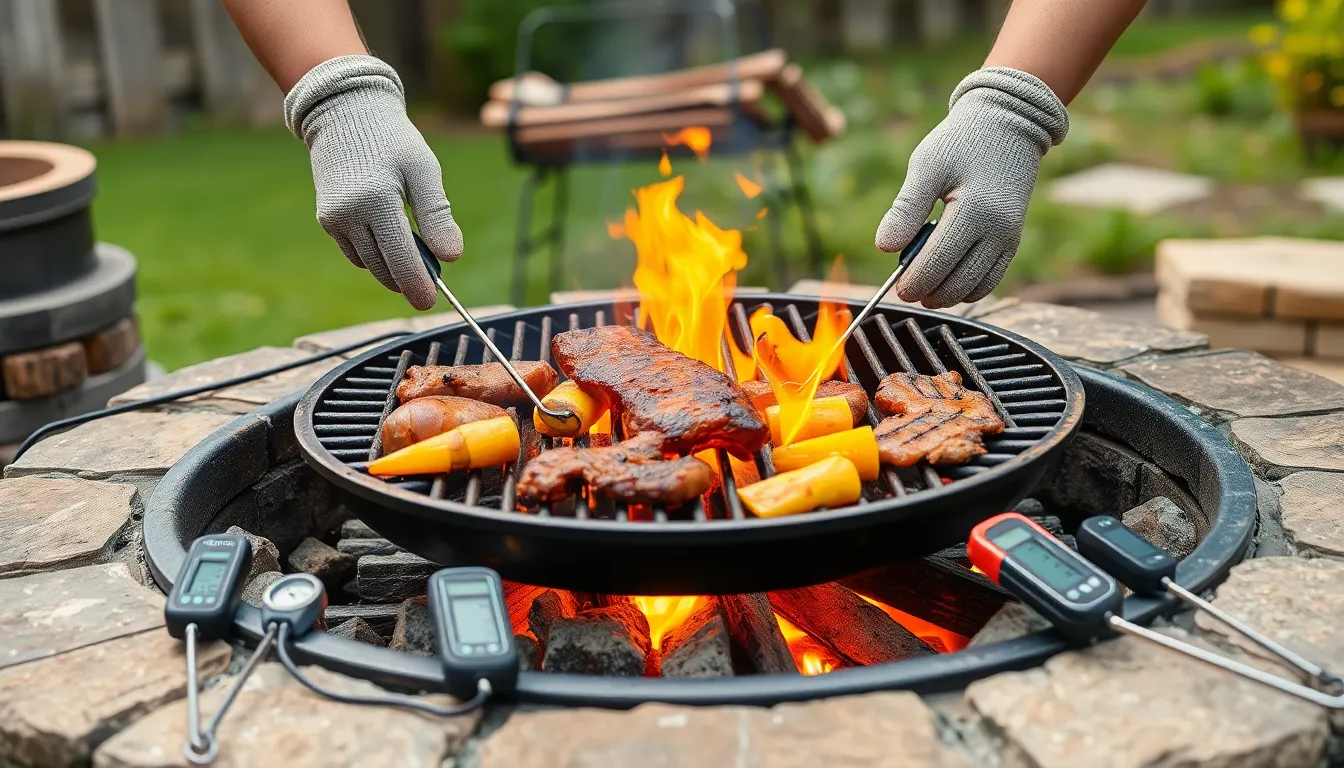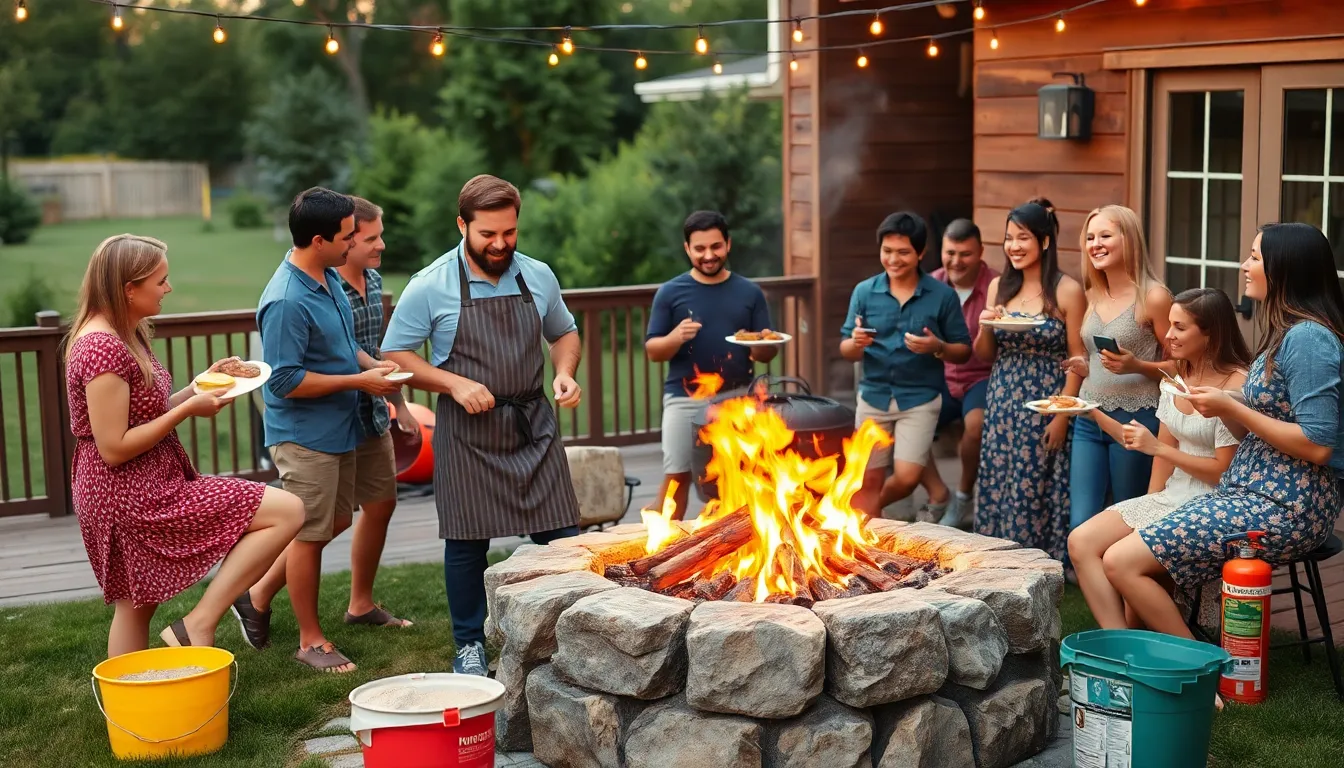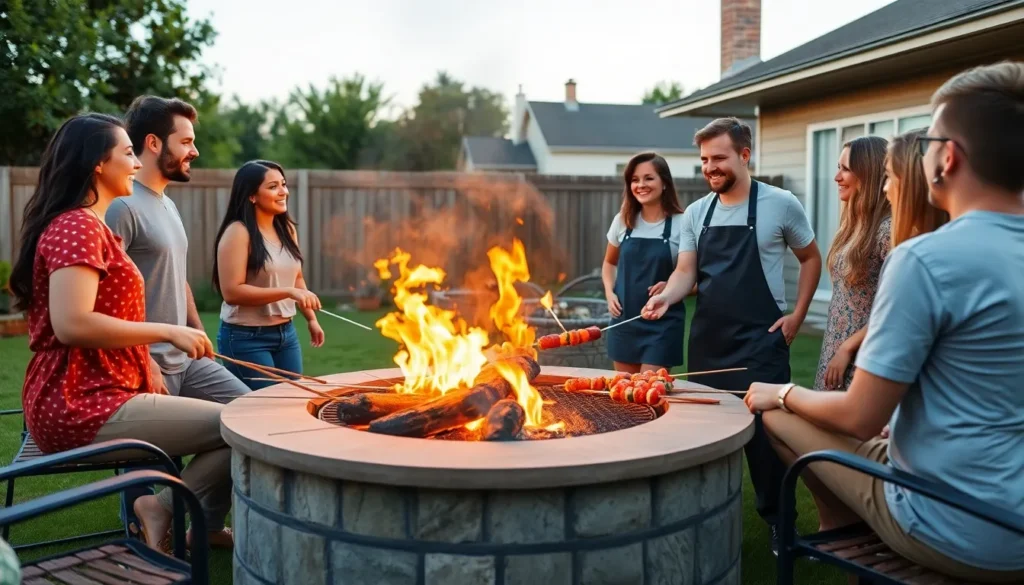There’s something magical about gathering around a crackling fire pit with the aroma of perfectly grilled food filling the air. We’ve all experienced that moment when flames dance beneath our favorite cuts of meat while friends and family share stories under the stars. Fire pit BBQ cooking transforms ordinary backyard gatherings into unforgettable culinary adventures.
Whether you’re a seasoned grill master or just starting your outdoor cooking journey we’re here to ignite your passion for fire pit barbecuing. From choosing the right equipment to mastering temperature control these essential techniques will elevate your outdoor cooking game beyond traditional grilling methods.
Ready to discover innovative fire pit BBQ ideas that’ll make your neighbors jealous? We’ll explore creative cooking methods delicious recipe combinations and expert tips that turn your fire pit into the ultimate outdoor kitchen. Let’s jump into the smoky industry of fire pit barbecuing and unlock flavors you never knew existed.
Classic Grilling Ideas for Your Fire Pit BBQ Setup
Building on your fire pit foundation, we’ll explore time-tested grilling favorites that deliver exceptional results over open flames.
Traditional Burger and Hot Dog Combinations
Burgers reach their peak flavor when cooked over the natural smokiness of fire pit coals. We recommend using 80/20 ground beef for the perfect balance of juiciness and flavor retention. Season patties with salt and pepper just before cooking to prevent moisture loss.
Hot dogs transform into gourmet treats when grilled over fire pit flames. Choose all-beef franks or artisanal sausages like bratwurst and Italian varieties for elevated taste. Rotate frequently to achieve even browning and those coveted grill marks.
Toppings make the difference between ordinary and extraordinary. Set up a condiment station with classic options like mustard, ketchup, and relish alongside gourmet additions such as caramelized onions, roasted peppers, and specialty cheeses.
Perfectly Grilled Steak and Chicken Options
Steaks benefit tremendously from fire pit cooking’s high heat and smoky environment. We suggest ribeye, New York strip, or filet mignon cuts for optimal results. Let steaks reach room temperature before grilling and season generously with coarse salt and cracked pepper.
Temperature control becomes crucial for perfect doneness. Create heat zones by arranging coals on one side of your fire pit for searing and maintaining a cooler area for finishing. Use a meat thermometer to ensure accuracy: 125°F for rare, 135°F for medium-rare, and 145°F for medium.
Chicken requires careful attention to achieve juicy results without overcooking. Bone-in pieces like thighs and drumsticks work best for fire pit grilling due to their higher fat content. Marinate chicken for at least 2 hours beforehand using olive oil, herbs, and citrus for enhanced flavor penetration.
Seasonal Vegetable Grilling Techniques
Spring vegetables like asparagus, zucchini, and bell peppers excel on fire pit grates. Brush with olive oil and season with salt before placing directly over medium heat. Cooking times range from 5-8 minutes depending on thickness and desired tenderness.
Summer produce including corn, tomatoes, and eggplant brings vibrant colors to your fire pit spread. Corn husks provide natural protection while grilling, creating perfectly steamed kernels with subtle smoky notes. Remove silk but leave husks intact for best results.
Fall offerings such as butternut squash, Brussels sprouts, and root vegetables require longer cooking times but reward patience with caramelized exteriors. Cut vegetables into uniform pieces and use foil packets with butter and herbs for even cooking distribution.
Creative Cooking Methods Using Fire Pit Heat

We’re expanding beyond basic grilling to explore versatile cooking techniques that transform your fire pit into a complete outdoor kitchen. These methods unlock new flavors and cooking possibilities you can’t achieve with traditional grilling alone.
Cast Iron Dutch Oven Recipes
Cast iron Dutch ovens excel at fire pit cooking because they retain heat evenly and create the perfect environment for slow cooking methods. We love using Dutch ovens for meals that need consistent temperature control over extended cooking times.
Dutch oven bread becomes incredibly simple when you master coal placement techniques. We recommend using 30 briquettes for a 14-inch Dutch oven to maintain 350°F temperatures, spacing coals evenly under the pot and on the lid. This bread recipe takes just 30-45 minutes and produces soft, flaky results that’ll impress your guests.
Pot roast transforms into a campfire masterpiece with the right Dutch oven approach. We slow cook beef with vegetables and spices for roughly 4 hours, allowing the cast iron to tenderize tough cuts into melt-in-your-mouth perfection. The consistent heat distribution creates restaurant-quality results in your backyard.
One-pot meals like chicken cacciatore, cornbread chili, and roast turkey with garlic sage butter showcase the Dutch oven’s versatility. We control cooking temperatures by adjusting coal placement rather than relying on gas controls, giving us precise heat management for complex recipes.
Foil Packet Meal Preparations
Foil packets offer the ultimate convenience for fire pit cooking while locking in moisture and flavors that would otherwise escape. We wrap ingredients in aluminum foil and cook them directly on hot coals or grill grates for incredibly simple cleanup.
Mixed vegetable medleys with herbs and butter create colorful, nutritious sides that complement any main dish. We combine seasonal vegetables like bell peppers, zucchini, and onions with fresh herbs to create packets that steam perfectly in their own juices.
Shrimp or fish packets with lemon and spices cook quickly over fire pit heat. We add citrus slices, garlic, and Mediterranean herbs to create restaurant-quality seafood dishes that take just 10-15 minutes to prepare.
Sausage, peppers, and onions make hearty foil packet meals that satisfy larger appetites. We slice ingredients uniformly to ensure even cooking and add bold seasonings that complement the smoky fire pit flavors.
Skewer and Kabob Variations
Grilling skewers and kabobs over fire pit heat represents classic outdoor cooking at its finest. We alternate meats, seafood, and vegetables on skewers to create visually appealing dishes that cook evenly over open flames.
Assorted meat combinations using beef, chicken, and pork create protein-rich kabobs with varied textures. We cut meats into uniform pieces to ensure consistent cooking times and prevent some ingredients from overcooking while others remain underdone.
Marinating techniques become crucial for tender, flavorful results when grilling over fire pit heat. We recommend marinating proteins for at least 2 hours before skewering, using acid-based marinades that break down tough fibers while infusing bold flavors.
Vegetable kabobs offer endless creativity with seasonal produce combinations. We thread colorful vegetables like cherry tomatoes, mushrooms, and bell peppers onto skewers, brushing them with herb-infused oils that caramelize beautifully over fire pit flames.
Quick cooking times make kabobs perfect for fire pit BBQs where guests want food fast. We typically grill skewers for 8-12 minutes total, turning them frequently to develop even char marks while maintaining juicy interiors.
International Fire Pit BBQ Flavor Inspirations

We’re taking your fire pit cooking global with flavor inspirations from around the industry. These international techniques bring exciting new tastes to your outdoor grilling experience.
Mediterranean-Style Grilled Dishes
Mediterranean fire pit cooking transforms your backyard into a coastal escape with fresh herbs, olive oil, and vibrant ingredients. Grilled flatbreads and pizzas become showstoppers when you spread pre-made pizza dough on your fire pit grill and top with pesto, sun-dried tomatoes, and mozzarella for authentic Mediterranean flavor.
Hummus and veggie pitas offer another crowd-pleasing option that highlights the region’s love for fresh ingredients. Warm pita bread spread with creamy hummus, then topped with chopped vegetables, olives, and feta creates a meal that’s both satisfying and light. Grill these until they’re crisp and infused with that signature smoky flavor.
Skewered kabobs represent the heart of Mediterranean fire pit cooking, incorporating lamb, chicken, or vegetables marinated in traditional herbs and spices. These kabobs deliver classic open-fire flavors that transport your guests straight to the Greek islands.
Asian-Inspired Fire Pit Cooking
Asian flavors adapt beautifully to fire pit cooking through creative marinades and grilling techniques that bring Eastern cuisine to your outdoor kitchen. Soy sauce, ginger, garlic, and sesame oil marinades transform ordinary chicken or beef skewers into aromatic Asian BBQ with a distinctive smoky twist.
Grilled flatbreads or rice paper wraps filled with your fire-grilled meats and fresh herbs create fusion dishes that blend traditional Asian elements with outdoor cooking methods. Cast iron cooking over coals opens up possibilities for stir-fry style vegetables that maintain their crisp texture while absorbing those essential fire pit flavors.
Fire pit Asian cooking succeeds when you focus on bold marinades and quick-cooking techniques that preserve the fresh, vibrant tastes characteristic of this cuisine style.
Latin American BBQ Traditions
Latin American asado traditions emphasize bold flavors and wood-fired cooking that’s perfectly suited for fire pit BBQ enthusiasts. Spatchcock chicken, steaks, sausages, and pork loins seasoned with cumin, paprika, garlic, and chili create the foundation of authentic Latin American fire pit cooking.
Grilled bananas bring Caribbean flair to your fire pit dessert options, prepared with cinnamon, nutmeg, and maple syrup to retain their natural juiciness and sweetness. This simple yet elegant dessert showcases how Latin American cuisine embraces both savory and sweet fire pit preparations.
Skewers with Latin-inspired marinades deliver the smoky, spicy flavors that complement outdoor cooking perfectly, emphasizing the bold seasonings that define this regional cuisine. Dutch ovens and cast iron skillets expand your Latin American fire pit repertoire, allowing you to prepare dishes like fruit cobblers and mac ‘n’ cheese that blend comfort food with international flair.
Essential Equipment for Fire Pit BBQ Success

Success in fire pit barbecuing depends on having the right equipment to cook safely and effectively. We’ll explore the essential tools that transform your fire pit into a complete outdoor cooking station.
Grill Grates and Cooking Surfaces
Heavy-duty grill grates form the foundation of successful fire pit cooking. We recommend investing in cast iron grates that fit securely over your fire pit for superior heat retention and durability. These sturdy surfaces allow you to grill meats, vegetables, and other foods directly over flames or embers.
Adjustable height grates give you precise control over cooking temperatures. Moving the grate closer to or farther from the heat source lets you manage cooking intensity for different foods. Cast iron Dutch ovens expand your cooking options dramatically, allowing you to prepare stews, baked goods, and slow-cooked meals while maintaining excellent heat retention.
Multiple cooking surfaces maximize your fire pit’s versatility. Griddle plates work perfectly for pancakes and eggs, while grill baskets make it easy to cook smaller items like vegetables without losing them to the flames.
Fire-Safe Tools and Utensils
Fire pit gloves protect your hands when handling hot equipment or logs during cooking. These heat-resistant gloves are essential for safely managing your fire pit barbecue setup. Long-handled fire tongs and pokers help you adjust wood and maintain an even flame without getting dangerously close to the fire.
Fire pit screens prevent embers from escaping, minimizing fire risks especially in windy conditions. We always recommend keeping a multi-purpose fire extinguisher rated for wood and gas fires nearby at all times. Essential BBQ tools include long-handled spatulas, tongs, grill brushes, and basting brushes designed for high-heat cooking.
Heat-resistant gloves specifically designed for grilling provide additional protection when handling hot grates and cookware. These tools ensure both convenience and safety throughout your fire pit cooking experience.
Temperature Control Accessories
Digital meat thermometers are indispensable for ensuring food safety and achieving ideal doneness. We recommend thermometers with smartphone app integration that let you monitor temperatures remotely while socializing with guests. This technology takes the guesswork out of perfectly cooked meats.
Chimney starters help you light charcoal evenly and get coals to cooking temperature faster. These tools create consistent heat distribution for more predictable cooking results. Campfire rotisseries allow slow, even roasting over the fire for enhanced flavor and texture in larger cuts of meat.
Hardwood selection plays a crucial role in temperature control and flavor development. Oak, hickory, and mesquite provide hot, long-lasting fires that add distinctive smoky flavors to your food. Quality accessories create a more enjoyable cooking process and help you host memorable fire pit gatherings.
Safety Tips for Fire Pit BBQ Cooking

Now that we’ve covered equipment and cooking techniques, let’s focus on the essential safety measures that ensure our fire pit BBQ experiences remain both enjoyable and secure.
Proper Fire Management Techniques
Position your fire pit at least 10 feet away from any flammable objects, including buildings, trees, fences, and furniture to prevent accidental fires. We should never use gasoline, lighter fluid, or other accelerants to start or intensify our fire pit flames, as these create dangerous situations.
Always open the grill lid before lighting to prevent gas buildup, and we must perform regular checks of gas lines and fittings for leaks when using gas grills. Never leave the fire or grill unattended during cooking sessions; if we must step away, another responsible adult should watch the fire.
Use proper fire starters designed specifically for BBQs rather than household accelerants that can cause unpredictable flame behavior. Keep our fires manageable by adding fuel gradually and maintaining consistent flame control throughout the cooking process.
Food Safety Guidelines for Outdoor Cooking
Keep raw and cooked foods separate using different cutting boards, utensils, and serving platters to avoid cross contamination. We should use a food thermometer to ensure meats reach safe internal temperatures before serving to our guests.
Store perishable items in coolers until we’re ready to grill them, maintaining proper cold chain temperatures even during outdoor cooking. Clean grill surfaces regularly to avoid grease buildup, which can cause dangerous flare ups and food contamination.
Wash our hands frequently when handling different food items, especially when moving between raw meats and ready to eat foods. Marinate foods in the refrigerator rather than at room temperature, and we should discard any marinades that have contacted raw meat.
Emergency Preparedness Measures
Have a fire extinguisher, bucket of sand, or garden hose nearby in case of uncontrolled flames that require immediate suppression. We should educate our guests on basic fire safety protocols, including stop, drop, and roll procedures if clothing catches fire.
Fully extinguish the fire before leaving the area by dousing flames with water or covering them with sand or dirt until no embers remain active. Be aware of local fire bans or regulations before starting our fire pit or BBQ session, as restrictions vary by location and season.
Create an emergency action plan that includes evacuation routes and emergency contact numbers, ensuring all participants know these procedures. Keep a first aid kit accessible during fire pit cooking sessions to handle minor burns or injuries that may occur even though our precautions.
Seasonal Fire Pit BBQ Menu Planning

We’ve discovered that successful fire pit barbecuing requires adapting our menus to complement each season’s unique characteristics and weather patterns.
Summer Entertaining Ideas
Grilled corn becomes the star of our summer fire pit gatherings, delivering that perfect char and sweetness everyone craves. We focus on quick-cooking recipes that won’t keep us hovering over hot flames during sweltering afternoons. Foil pack dinners excel during summer months—we combine fresh vegetables like zucchini, bell peppers, and cherry tomatoes with your choice of chicken, fish, or shrimp for complete meals that cook in 15-20 minutes.
Classic BBQ staples like burgers and hot dogs remain crowd favorites, but we elevate them with quality ingredients and creative toppings. Skewers and kabobs add vibrant colors to our summer spread—we marinate chunks of beef, chicken, or lamb with Mediterranean herbs, then alternate with fresh vegetables like red onions, mushrooms, and colorful peppers. Light flavors work best in warm weather, so we incorporate citrus marinades, fresh herbs like basil and mint, and plenty of seasonal produce that cooks quickly over direct heat.
Fall and Winter Comfort Foods
Rustic apple and cinnamon foil packets transform our fire pit into a dessert station during autumn evenings. We slice fresh apples, toss them with cinnamon, brown sugar, and honey, then seal everything in foil packets that grill to perfection in just 10-12 minutes. Vanilla ice cream makes the ideal accompaniment, creating that perfect warm-cold contrast everyone loves.
Campfire chili becomes our go-to winter BBQ centerpiece, combining ground beef, kidney beans, diced tomatoes, and warming spices in a Dutch oven. We let this hearty dish simmer slowly over the coals, developing deep smoky flavors that penetrate every ingredient. Cheese and sour cream make excellent toppings that balance the heat and richness.
Grilled butternut squash offers a seasonal vegetable side that showcases fall’s bounty perfectly. We brush thick slices with olive oil and maple syrup, creating caramelized edges with tender, sweet interiors. Fire-seared flank steak with garlic chimichurri provides protein that pairs beautifully with roasted root vegetables and crusty artisan bread for those satisfying winter meals.
Holiday-Themed Fire Pit Gatherings
Thanksgiving gatherings benefit from our fire pit’s cozy ambiance, where we highlight seasonal produce like pumpkins, sweet potatoes, and crisp apples. We create Dutch oven enchiladas using fall vegetables, or prepare sweet potato and apple hash that develops incredible depth from the wood smoke. Foil packets work wonderfully for individual portions of holiday sides.
Spiced ginger apple cider becomes our signature holiday beverage, warming guests from the inside while they gather around the flickering flames. We add cinnamon sticks, star anise, and fresh ginger to create aromatic steam that enhances the entire outdoor experience.
Winter holiday celebrations call for festive spices in our hot beverages and comfort foods that encourage lingering conversations. We serve traditional favorites like chili or slow-roasted meats that benefit from the fire’s warmth, creating memorable outdoor feasts that bring families together even though chilly temperatures.
Budget-Friendly Fire Pit BBQ Solutions

Creating an amazing fire pit BBQ experience doesn’t require very costly. We can build incredible outdoor cooking setups for $50 to $150 while store-bought options often cost $300 or more.
DIY Fire Pit Construction Tips
Building your own fire pit gives you complete control over design and size while dramatically reducing costs. We recommend starting with retaining wall blocks and pavers for beginners, creating a sturdy structure without mortar or grout for around $50.
Stone rings offer another cost-effective approach using stones from your yard or local suppliers. Gather uniform stones and arrange them in a circle, ensuring proper drainage and airflow for optimal burning.
Metal fire pit rings around 36 inches work perfectly as construction templates. Dig a cylindrical hole matching the ring diameter, then line it with pavers in carefully leveled layers for stability and safety.
Repurposed materials can slash construction costs even further. Stainless steel washing machine drums provide excellent heat resistance and natural airflow, transforming discarded appliances into functional fire pits.
Planning projects during off-season months like fall or winter helps secure materials at important discounts. We suggest adding DIY benches from reclaimed wood or pallets to maximize seating while maintaining your budget focus.
Affordable Ingredient Combinations
Smart ingredient selection transforms fire pit cooking into budget-friendly feasts without sacrificing flavor. Chicken thighs and drumsticks cost significantly less than premium cuts while delivering superior taste and moisture retention.
Sausages and hot dogs provide foolproof grilling options that please crowds without straining wallets. We pair these proteins with seasonal vegetables like bell peppers, onions, and corn on the cob for balanced, economical meals.
Homemade marinades using pantry staples create restaurant-quality flavors at fraction costs. Combine paprika, garlic powder, salt, and pepper with oil and vinegar for versatile spice rubs that enhance any protein.
Skewer combinations maximize ingredient value by controlling portions while adding visual appeal. Mix affordable cuts with colorful vegetables, creating satisfying meals that stretch protein further while maintaining nutritional balance.
Cost-Effective Equipment Alternatives
Repurposing existing items eliminates expensive equipment purchases while maintaining cooking quality. Wire racks from old grills adapt perfectly to fire pit cooking, providing essential grilling surfaces at zero cost.
Metal cooling racks and oven racks serve as excellent alternatives when sized appropriately for your fire pit. We modify these kitchen tools to create custom cooking surfaces that rival expensive commercial options.
DIY skewers from metal rods or sturdy wooden sticks replace costly specialized tools. These homemade alternatives perform identically to store-bought versions while saving substantial money for other barbecue essentials.
Natural fuel sources like charcoal or wood scraps add authentic flavors while costing less than gas or propane setups. We collect fallen branches and purchase affordable charcoal to maintain consistent heat without ongoing fuel expenses.
Solar lanterns provide ambient lighting without increasing utility costs or requiring electrical connections. These low-cost additions create perfect atmosphere for evening gatherings while staying within tight budgets.
Conclusion
We’ve shown you how fire pit BBQ cooking can transform your outdoor gatherings into unforgettable culinary adventures. From mastering essential grilling techniques to exploring international flavors we’ve covered everything you need to create amazing meals around the fire.
Remember that successful fire pit cooking combines the right equipment proper safety measures and creative recipes. Whether you’re working with a budget-friendly DIY setup or investing in premium gear the key is experimenting with different techniques and flavors.
Your fire pit isn’t just a cooking tool – it’s the centerpiece for creating lasting memories with family and friends. Start with simple recipes build your confidence and gradually explore more adventurous cooking methods. The combination of great food flickering flames and good company will make every gathering special.
Frequently Asked Questions
What essential equipment do I need for fire pit barbecuing?
You’ll need heavy-duty cast iron grill grates for superior heat retention, adjustable height grates for temperature control, and safety tools like fire pit gloves and long-handled utensils. A digital meat thermometer, chimney starter, and fire pit screen are also crucial. Don’t forget grill baskets and griddle plates for versatile cooking options.
How do I control temperature when cooking over a fire pit?
Use adjustable height grates to move food closer or farther from heat. Create different heat zones by raking coals to one side. Select appropriate hardwoods for consistent temperature control, and use a digital thermometer to monitor both fire and food temperatures. A chimney starter helps achieve even heat distribution.
What are the best foods for beginners to cook on a fire pit?
Start with simple favorites like burgers, hot dogs, and grilled vegetables. These foods are forgiving and cook quickly. Use quality ingredients and proper seasoning. Foil packet meals are also excellent for beginners as they lock in moisture, prevent burning, and make cleanup easy while you learn fire management.
What safety precautions should I follow when fire pit cooking?
Position your fire pit away from flammable objects and never leave it unattended. Keep raw and cooked foods separate, use food thermometers for safe cooking temperatures, and have fire suppression tools nearby. Educate guests on safety protocols and create an emergency action plan before cooking begins.
Can I cook international cuisines on a fire pit?
Absolutely! Fire pits are perfect for Mediterranean grilled flatbreads, Asian-inspired marinaded skewers, and Latin American wood-fired dishes. The key is adapting marinades, seasonings, and cooking techniques to complement the smoky fire pit flavors. Experiment with different spice blends and cooking methods for authentic international tastes.
How can I create budget-friendly fire pit BBQ meals?
Use DIY fire pit construction with retaining wall blocks and repurposed materials. Focus on affordable ingredient combinations like seasonal vegetables and budget-friendly protein cuts. Repurpose existing kitchen tools as fire pit equipment and use natural fuel sources. Smart planning and creativity can create amazing meals without overspending.
What’s the best way to cook with a Dutch oven over a fire pit?
Cast iron Dutch ovens are perfect for fire pit cooking due to their heat retention. Place coals both under and on top of the lid for even heating. They’re ideal for slow-cooked meals, bread, pot roast, and one-pot dishes like chili. Season properly and control heat by adjusting coal placement.
How do I plan seasonal fire pit menus?
Summer focuses on quick-cooking items like grilled corn and fresh vegetable foil packs. Fall and winter emphasize comfort foods like campfire chili and rustic apple packets. Holiday gatherings feature seasonal produce and warming beverages. Adapt recipes to complement each season’s characteristics and available ingredients for optimal flavor.







